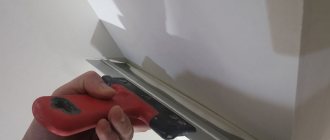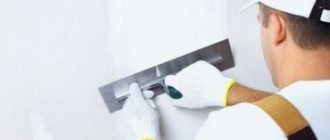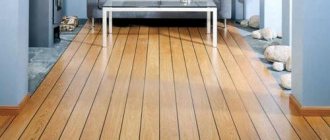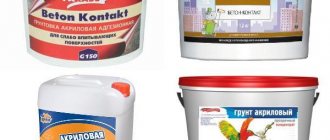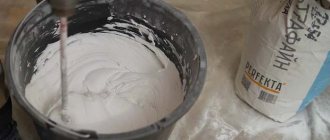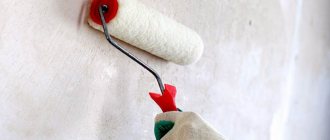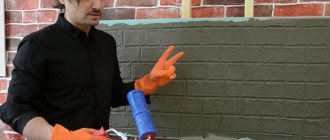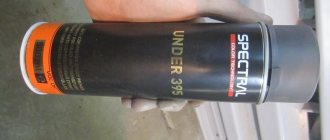Types of wood putty
There are several types of material available on the market, differing in the binder. Strength depends on it, as well as the maximum layer that can be applied to putty in one pass, moisture resistance, and drying time.
Acrylic
The light, almost white composition of the consistency of sour cream easily penetrates into the cracks, filling the unevenness. The hardened putty adheres perfectly to the wooden surface.
Pros:
- high adhesion;
- strength after hardening;
- forms a layer up to 3 mm.
Minuses
- not used in cold weather;
- only light colors: oak, pine; white.
Acrylic putty for wooden floors
Serves as an optimal base for water-dispersed paints and varnishes.
Polymer
Prepared on a water basis. Perfectly matches parquet or tongue and groove boards.
Pros:
- plasticity allows it to flow into the narrowest cracks;
- low shrinkage makes it possible to get by with a single layer.;
- quick drying.
Minuses:
Not suitable for hard wood, cork floors, causes stains.
Polymer compositions must be selected strictly to match the tone of the floor material.
Solvent based
The compositions tend to dry quickly. Essential resins diluted with organic solvents are used as a binder. The basis is wood dust generated during woodworking. It is recommended to use dust from the same wood from which the floor material is made. This will allow you to achieve maximum naturalness, especially when using colorless varnishes.
Pros:
- ease of application;
- quick drying;
- low shrinkage;
- natural look.
Minuses:
- sharp unpleasant odor at the time of application;
- the need for ventilation until completely dry.
Supplied as a colorless base, which is tinted with pigments. Ready-made compositions painted in one color or another are also available.
Oily
The composition of the putty includes water, oil, chalk. Suitable for treating all types of wood floors. High strength and a large number of available shades make oil compositions one of the most popular. They repel moisture, are resistant to low temperatures, strong, durable.
Pros:
- rich palette of shades;
- water-repellent properties;
- suitability for outdoor use.
Minuses:
- During the long drying period, you cannot walk on the floor;
- The strong smell requires frequent ventilation of the room.
Oil-based putties are supplied in a variety of packaging, from small tubes to 20-liter buckets. For any amount of work you can choose the right container.
Making homemade putties
A good putty composition should have the following characteristics:
- strength of the formed coating;
- quick drying (no more than 7-8 hours);
- good adhesion;
- plasticity (simplifies working with the material);
- the coating should not crumble;
- absence of harmful toxic fumes;
- smooth texture of the hardened coating;
- resistance to humidity and temperature changes;
- ease of use;
- affordability and the ability to find all components for free sale.
Wood putties
There are several options for homemade putty for wood processing:
- Based on PVA glue with chalk. The substances are mixed with each other until a creamy consistency is obtained. If the surface is too uneven, add wood dust and fine sawdust to the mixture. The main disadvantage of PVA and chalk putty is the long drying time. You will have to wait at least a day for the surface to set.
- Chalk with nitro varnish. Chalk and small sawdust are mixed with the main component - nitro varnish. If desired, you can create a colored composition by adding gouache or a building pigment of the appropriate color. In addition to the coloring matter, you need to add a little solvent No. 647. The main positive characteristic of nitro varnish is the quick drying of the surface. However, there is a significant drawback - the composition is toxic and has a strong unpleasant odor.
- Chalk with acrylic varnish. Water-dispersed paint and varnish material is mixed with chalk. Moreover, there is no need for expensive varnish; any inexpensive composition will do. The components are mixed to a paste. If necessary, add water to make the paste less thick. The color of the composition is changed by adding a color for acrylic paints. The main features of acrylic materials are elasticity and resistance to moisture. If the surface has deep crevices, it is recommended to add fine sawdust to the mixture. The composition dries within 2-6 hours. Specific dates depend on air temperature.
Advice! It is recommended to produce all types of putties in small quantities. Otherwise, damage to the composition cannot be avoided, since it dries out quickly.
The solution is applied to wooden surfaces using a flexible rubber spatula. The coating is sanded using sandpaper on a block or a grinder.
Putties for painting, wallpaper, concrete and plaster
For treating concrete and plastered walls, gypsum-based putties are most often offered. This is not the best material as it dries out too quickly. As a result, you have to prepare the putty in too small portions. In this regard, it is more correct to use a homemade composition:
- Putty on carpentry or wallpaper glue. Components: chalk - 10 kg, 15% glue - 1 kg, turpentine, laundry soap and drying oil - 25 g each. All of the above is stirred to a paste.
- Acrylic putty. You will need the following elements: chalk - 10 kg, acrylic primer - 10 l, 10% wood glue - 2 l. Mix the mixture until you get a paste.
- Casein paint putty. Ingredients: casein paint - 10 kg, water - 7 l. The mixture is diluted with water. Then the liquid composition is heated to 60 degrees. The hot solution is filtered through a sieve. Add 300 g of drying oil to it. The last component to be added is 23 kg of wet chalk.
- Putty based on casein glue. Instead of paint, glue is used, and instead of 300 g of drying oil, only 30 is added. Otherwise, the components and preparation procedure are the same.
How to prepare a solution with your own hands?
Preparing a solution for finishing parquet
To prepare your own putty, there are two methods.
Method No. 1
This is the simplest and most affordable technology for mixing your own solution for treating parquet. To prepare it you will need PVA glue and wood dust (it always remains after sanding the parquet).
According to many craftsmen, you can use other finely ground shavings, but only the one that you have left after processing your material will give the solution the maximum color similar to the installed parquet. Therefore, if you do not plan to putty the parquet today, save at least a small amount of wood dust, which will be very useful when eliminating defects on the floor in the future.
It is quite simple to prepare such a composition: constantly stirring the glue, pour wood dust into it until the solution becomes homogeneous and of the correct consistency.
The advantage of this putty is its low cost and quick mixing.
Unfortunately, there are also disadvantages - the solution is not sufficiently resistant to mechanical damage and subsidence during the drying process.
Parquet finishing
Method No. 2
Using this technology, mixing the solution is much more difficult, and you will also need more components. But, in its defense, we can say that such a mass will be more efficient, with increased stability and reliability.
To prepare this mixture for parquet putty you will need:
- 500 g drying oil;
- 125 g of turpentine (can be replaced with varnish kerosene);
- 100 g animal glue (10%);
- 25 g of liquid drier;
- soap (liquid);
- chalk (it must first be crushed into powder).
The cooking technology has the following sequence:
- animal glue is placed in a metal container and put on fire to heat up, without ceasing to stir;
- add all other components into the hot glue, constantly stirring the resulting mass;
- To make the mixture resemble sour cream in thickness, add the required amount of liquid soap and crushed chalk to it.
Second method of creating mass
Components used:
- drying oil - 500 g;
- animal glue - 100 g;
- desiccant in liquid form - 25 g;
- liquid soap;
- chalk.
Method of preparing the mixture
Initially, it is recommended to heat the animal fat to a liquid state. And the remaining components of the homemade putty are poured into it and poured into it. In this case, chalk in powder form is added until the consistency of “liquid sour cream” is obtained.
Due to the fact that the substance ends up being transparent, it can be used to fill parquet of any type of wood. But please note that this composition is applied warm.
Important! In construction stores there is a special liquid mass, adding wood dust to which you will have a ready-made substance for puttingtying parquet.
Putty composition and its varieties
Preparation of floor putty
Depending on the purpose, parquet putty can be:
- parquet starting or base, which is used for “rough” elimination of noticeable holes and irregularities;
- the finishing putty mixture is used at the final stage to final level the floor surface;
- A universal putty composition for all types of wood is used simultaneously at the initial and final stages of repair. In this case, they perform both “rough” work and final leveling of the floor.
Depending on the composition, putties are divided into types:
gypsum mixture has earned popularity due to its universal purpose. Plus, this composition provides reliable adhesion to the floor surface and has a low cost. They are used for both “rough” work and for final leveling of parquet.
Gypsum putty mixture for parquet
- Oil putty can be used for various types of wood. A significant disadvantage of this type of composition is the drying time due to the presence of oil.
- acrylic putty for parquet is used for work related to the removal of small defects in the floor covering. This mixture is environmentally friendly, elastic and resistant to mechanical stress. A significant disadvantage of putty is the low adhesion of the mixture to the edges of the parquet planks. During operation, the gaps increase, accompanied by the putty material falling out of the cracks.
Acrylic putty
- alkyd putty is made on the basis of flax oil, soybean and others. It is viscous, elastic and amenable to grinding. Used for finishing work.
- latex mixture for parquet is recommended for final decorating work. In this case, it can be used for unevenness of up to two millimeters. Otherwise, the surface layer of the parquet may crack. This mixture adheres perfectly to the surface, which is smooth and uniform. Plus, it’s worth noting the vapor-tight characteristics of latex floor putty. The cost of such products exceeds the price of standard gypsum building materials.
- the mixture or dispersion requires modification of the composition. In this case, there is no need to purchase a special dye. You can take the remaining dust from the top parquet layer and mix it with the mixture. As a result, you will have an excellent material for leveling parquet planks with recesses of up to 6 mm. This is one of the cheapest ways to restore the appearance of flooring.
Dispersion for parquet
Depending on the composition of the putty base, there are:
water-based putty is characterized by drying speed and environmental safety in terms of the complete absence of toxic fumes;
Application technology
To perform a high-quality restoration, you must follow the rules for processing parquet. Applying putty to a wooden surface is a prerequisite for restoring the coating. The work should be carried out according to these steps.
- Primary scraping of the floor is cutting off the part of the covering that has become unusable.
- Remove large and small debris using a vacuum cleaner or other devices.
- Use a damp cloth to finally clean the parquet surface and dry it thoroughly.
- If necessary, the coating is degreased.
- Putty, ready-made or made by hand, is applied with a spatula in a circular motion to the floors, starting from the corner and moving towards the doors along the surface.
- Carry out thorough sanding using a machine or by hand.
Why do you need parquet putty?
Regular puttying of the coating is a procedure that extends the life of the parquet. In addition, the composition eliminates damage to the integrity of the lamellas, which eliminates the risk of complete deformation of the coating. Putty is needed if:
- cracks appeared due to improper installation or during use of the floor;
- The dies have shifted, chips, cracks, and stains have been discovered.
In the first case, filling parquet with your own hands can be done during the sanding process, after the varnish coating has been applied, or without sanding the floor at all. And in the second, the defects should be cleaned, leveled and sealed with putty matched to the tone of the coating.
Instructions for performing work
Like puttying any other surfaces, wood processing consists of several stages.
Surface preparation
The preparatory process consists of clearing the room of furniture and other household items. We protect large heavy furniture with polyethylene. We also cover the floor with plastic wrap or old newspapers. We also do not forget about our own safety: wear safety glasses, a respirator, and rubber gloves.
Surface cleaning
Apply wood putty before painting to as smooth and clean a surface as possible. We remove traces of old paint or plaster. To do this we need an abrasive material or solvent. We also remove all nails and other metal parts from the product. If the metal is left, it will later be affected by corrosion, which will negatively affect the integrity of the coating. Finally, treat the surface with a brush and a damp cloth.
Padding
Without priming it is impossible to achieve good adhesion of materials. In addition, many formulations contain antiseptic agents that will protect the wood from microorganisms. It is recommended to choose a primer with the same base as the putty - homogeneous materials combine better. Next we’ll talk about how to putty wood.
When is it used?
Restoration of parquet flooring consists of repairs to restore the old wooden flooring. The main task in repairing parquet is to eliminate defects and improve the appearance of the floor. You can repair and renew the surface yourself.
Let's look at the most common defects that require floor sanding.
Crevices. The main factor in the formation of cracks is the loosening of parquet boards. Removing cracks is a difficult task because they appear throughout the entire coverage area. Small cracks can be sealed with putty. When visible cracks form in the middle of the planks and the surface is scratched, cosmetic repairs are not enough. If the parquet is not detached from the base, then it is necessary to restore the floor covering.
Otherwise, later the parquet will have to be removed and laid again. The restoration takes place in the following stages: sanding, sanding, filling and filling of uneven areas, sanding the putty floor, final finishing.
To care for parquet floors, you can purchase special oil. First, dust is removed from the parquet, wet cleaning is carried out, and then oil is applied. Do not apply a thick layer of oil to prevent the floor from sticking. Initially, such a coating will get dirty faster, but after a while it will become easier to care for the floor.
Basic mistakes when working
It happens that the completed repairs soon begin to deteriorate and the putty areas are destroyed. The main reason is a violation of the work technology when sealing chips, crevices, cracks, as well as when laying parquet. Often the putty does not last long if the individual lamellas are poorly secured. They become loose and the mixture cannot stay in the gap.
Another possible reason for the poor quality of the repair could be incorrect production of the putty or violation of the proportions of mixing the components. Problems can also arise when applying too thin a layer or with a small number of layers, or when the drying time of the material is not observed.
How to putty parquet - buy the necessary ingredients
Parquet putties can be water-based, oil-based, or acrylic. According to experts, small cracks do not need to be sealed when applying putty, as they will be filled with varnish during subsequent varnishing. But in large cracks, a special solution is applied to the maximum.
Putties are divided into several types: leveling or starting putties, finishing putties; in addition to them, universal putties, decorative putties and wood putties are also in demand. According to their classification, they are alkaid, acrylic, latex and oil. You should buy a powder or paste substance (putty) in a store. There they will tell you which one is best for you to level your floors. The appearance of the parquet, as well as its wear resistance, will largely depend on the putty purchased. Putty in the color of oak, birch, beech or pine is often in demand. There is no less demand for a universal putty mass (we can add parquet dust to it ourselves).
There are joint fillers that come with the primer that have fast drying properties and are suitable for both wood floors and ceramic tiles. Varnishes combine well with oil and acrylic putty. The best putty is the one that creates a perfectly smooth floor, smooths out cracks and eliminates defects, masking the gaps at the joints of the planks. The elasticity of the putty is also of great importance. For small seams, skilled craftsmen use wax along with a special pencil (retouching) and varnish. And your parquet will be like new! By the way, if you fail, blame yourself - sealed seams “by eye” can lead to poor quality of parquet installation.
Functional purpose of parquet putty
Putty for parquet after drying.
It is recommended to use the putty mixture:
- for sealing gaps and cracks between individual parquet planks. These defects can occur if the floor covering is not installed correctly, including during operation. For example, after changing the microclimate in the room, changing temperature parameters and humidity. Puttying of planks is permitted during sanding when varnish is applied.
- to give the flooring a presentable appearance after use, when chips, cracks, stains and other defects are noticeable. In this case, the damaged area is first cleaned, and then the tone is leveled by applying putty.
Types of putty for wooden floors
Today, the construction market offers a large number of different putties for wooden floors, which, based on their composition, can be divided into several main types:
- solvent-based putty mixtures;
- acrylic mixtures;
- oil putties;
- polymer mixtures;
- DIY mixtures.
- Solvent-based mixtures contain fine wood chips as the main component, which are considered a reliable coating for floor coverings made of any type of wood. The main positive characteristics of this composition are ease of use and quick drying of the mixture, which significantly speeds up the process of laying or repairing the floor.
Solvent based mixture.
- Acrylic parquet putty also has several positive qualities and is indispensable in work on eliminating minor wood defects. It is often used for grouting joints between wooden tiles, as it is environmentally friendly and does not release toxins when exposed to high temperatures. The main quality is elasticity and resistance to various mechanical loads. Acrylic also significantly increases the water-repellent qualities of wood and significantly increases its service life.
Acrylic mixture for puttying parquet floors.
- Oil compositions contain components such as oil, water and regular chalk, which makes it possible to use it on any type of wood. The putty has a very long service life, however, due to the presence of oil in the composition, it takes a very long time to dry, which significantly reduces the speed of work. Putting parquet with your own hands using oil mixtures requires strict adherence to the instructions for use, which are indicated on the packaging from the manufacturer.
Oil mixture for parquet putty.
- Polymer solutions are environmentally friendly and are usually used in rooms with increased sanitary requirements. Can be used on any type of wood except cork. The main advantages of polymer putty mixtures are the following features:
- filling small voids and cracks;
- smoothing out unevenness and other natural defects;
- protection of the end edges of the tree;
- does not settle after drying;
- does not create static electricity, which prevents dust from sticking.
Polymer mixture for puttying wooden floors.
- It is very often practiced to putty parquet from personally prepared solutions, which allows you to significantly save money and make exactly the composition that is necessary for a particular case.
Homemade putty mixture
First option
In order to prepare this mixture at home, you need the following ingredients:
- 500 grams of drying oil;
- 100 grams of animal glue with 10% concentration;
- 125 grams of varnish kerosene or turpentine;
- liquid drier 25 grams;
- liquid soap;
- regular chalk in powder consistency.
Heated animal glue.
Animal glue is heated in a metal container over a fire, stirring constantly. While heated, the remaining ingredients are added to the glue and stirred until a mixture is formed, which in consistency will resemble thick sour cream. This solution is mainly used as a putty for parquet: oak, aspen or pine.
It is important to remember that the mixture must be used only in a warm state, maintaining its constant temperature during operation
Option two
The second option is a simpler, but no less effective method of preparation.
To do this, you need to take regular PVA glue and add wood dust that remains after processing your parquet. The dust is mixed with glue to form a thick mass (photo) and applied to the surface using a spatula. This type of putty will provide a natural color when sealing joints, but it has its drawbacks. When the glue dries, it settles and hardens.
Self-prepared putty from PVA glue and wood dust.
Putty process
Before puttingtying the parquet, it must be thoroughly vacuumed and, if possible, wiped with a damp cloth. Puttying is used in all types of work, both when installing new parquet and when repairing or maintaining old ones.
The putty is applied to the parquet using a regular metal spatula in a circular or semicircular motion in order to fill all the seams and small cracks as much as possible. After the mixture has hardened, the floor is ready for polishing.
Puttying parquet.
Making your own putty
You can make putty yourself. Craftsmen offer several recipes:
- Sifted chalk is mixed with gypsum in a 2:1 ratio with the addition of PVA glue. The mixture acquires a viscous, thick consistency and is used to level concrete bases. When working with large surfaces, sawdust is added to the composition. This putty dries in no less than 2 days.
- Sifted chalk is mixed with acrylic varnish. In this case, the putty acquires a paste-like consistency.
- Floors in rooms with high humidity are leveled with oil-based compounds. To do this, chalk is mixed with drying oil in a 2:1 ratio and additives are added to accelerate the hardening of the putty.
- When working with wooden surfaces, a composition of wood dust and varnish with an oil base is used.
- The original moisture-resistant composition can be obtained from old linoleum. To do this, the material must be finely chopped and poured with acetone until the linoleum dissolves.
- A durable composition can be obtained by mixing cement and varnish.
- An analogue of acrylic putty is made by mixing the following substances in a metal container set on fire: rosin (200 g), ozokerite (400 g), yellow ocher (400 g). The latter is added when the first two components are melted. This composition is used exclusively hot. Purpose – putty on chipboard and wooden surfaces.
Ozokerite
Individual protection means
Oil-glue and adhesive putty: manufacturing features
These types of homemade putties are used to work with wooden surfaces. The composition turns out to be moisture-resistant and of fairly high quality, so it is popular among home craftsmen. Ingredients you will need:
- Flaxseed oil (280 g).
- Turpentine oil or turpentine (60g).
- Powdered perlite (30g).
- Casein (20g).
- Edible gelatin (20g).
- Borax (12 years old).
- Ammonia 18% (18 g).
- Water (300 g).
One of the components of homemade putty
The putty is prepared as follows:
- Powdered pumice is poured into a metal container and mixed until smooth with linseed and turpentine oil.
- Then water, casein, gelatin and borax are added sequentially.
- The ingredients are mixed and heated in a water bath to 90 degrees, stirring the mixture.
You can give this putty the desired shade using wood dust. The viability of such a material lasts for an hour, then its properties decrease.
Flaxseed oil can be purchased at most hardware stores.
To prepare glue-based putty, you need to mix PVA and chalk to a creamy or paste-like consistency. Then sawdust is added to the composition and, after swelling, the mass is used for its intended purpose. This putty dries after a day or more, depending on the thickness of the layer. A similar composition will dry faster if a water-soluble inexpensive varnish is added instead of glue.
Types, advantages and disadvantages of putty
Today, parquet putty is classified into several types.
Depending on its purpose, the putty received the following names:
- starting (basic) – used for “rough” filling of large defects;
- finishing – designed for final leveling of the surface where there are minor defects. The essence of its use is that it should be applied to facing material or a clean base;
- universal (for use on wood) – has a number of characteristics, combining the properties of starting and finishing mixtures.
Depending on the substances included in the putty, there are several varieties of this product.
Gypsum - popular due to its versatility, reliable adhesion to the base and low cost. This mixture can be used for both rough and finishing application.
Oil is a parquet putty that goes well with any type of wood. The disadvantage of this mixture is that it takes a long time to dry due to the oil base.
Acrylic - used as a means to eliminate minor surface defects and rub joints. This mixture is created on a water basis, is environmentally friendly, has high elasticity and resistance to physical stress. There is a problem with the operation of such a mixture, which consists in poor interaction with the edges of the cavity being filled when applied to the coating. After some time, the seams of the floor covering may expand slightly, which leads to the loss of a layer of putty.
Alkyd - made from resins from soybean, flax, etc. oils. This mixture has many advantages: high viscosity, elasticity and ease of grinding.
Latex - the mixture is similar to alkyd and is also used as parquet putty with improved characteristics. Apply a layer of no more than 2 millimeters, since with increasing thickness the risk of cracking increases. Advantages of use: good interaction with smooth surfaces, high vapor permeability. However, the cost of such a mixture is much higher than gypsum.
A dispersion is a set of materials for making your own putty. The purchased base can be supplemented with dust remaining after sanding the floors. In this case, the putty you create for parquet yourself will have a color similar to the flooring. The applied layer can be up to 6 millimeters thick. The cost of such a mixture is low and any owner can use it.
Also, putties are divided into types depending on the active substance on the basis of which production is carried out:
- If parquet grouting is done with water-based putty, the applied layer dries quickly and is also environmentally friendly and safe for owners. The mixture does not interact well with hardwood parquets: chestnut, oak, cedar, etc.;
- If the parquet is puttied using a solvent, then it is permissible to use a mixture with any wood materials. The mixture has higher strength than water. The varnished coating interacts with such putty no worse than pure wood. The disadvantage is that there is a high risk of fire and the mixture has an unpleasant odor due to the solvent it contains.
Selecting a mixture by manufacturer
Swedish BONA
can be proud of its water-dispersed acrylic composition “Bona Mix&Fill”. This mixture refers to putties that acquire the color of the parquet being processed when dust is added to it after sanding. As for the treatment of pure wood parquet flooring, the best solution would be putty with PARKETTGRUND solvent as a base.
German Loba
It has a high-quality water-based putty that adheres well to the surface, dries quickly and has low consumption during operation. But the material, which is based on the LOBADUR Fugenkittlosung solvent, is valued, since it adheres well to wood flooring and is highly elastic.
Also in Germany, you can highlight the company Uzin, which produces quick-drying putties for any parquet. Moreover, their use on heated floors is permissible.
Italian Chimivers
produce a universal putty with universal performance characteristics and ease of sanding after the layer dries. There are varieties both water-based and solvent-based.
The varieties of mixtures used do not end there. Mixtures produced in Belarus will cost owners cheaper and without loss of quality. Qualified construction store managers will help you choose the most suitable mixture for a specific coating and room.
Which putty for parquet is better?
It's hard to say which floor grout is better. Here you need to take into account the operating characteristics of the floor covering, as well as the microclimate in a particular room. To understand this issue, let’s get acquainted with the popular types of putty, their technical characteristics, advantages and disadvantages.
According to their intended purpose, building mixtures are divided into the following types:
- Starting solutions with a maximum fraction of fine aggregate are used to fill large uneven areas on the surface of the floor covering. These could be seams between individual dies or chips.
- Finishing types of mixtures are used for final leveling before laying the protective layer.
- Universal putty can be used for the two previously listed types of work.
In addition, there is a division of grouts according to the composition of raw materials. Based on this criterion, the material can be divided into the following types:
- On a gypsum basis. Such materials are distinguished by their universal use, low cost, and good adhesion to any type of base surface. Such solutions are used for initial or finishing surface treatment of floor coverings.
- Oil putty is made from natural raw materials, which is considered its main advantage. This solution can be used for any type of wood and fills the gaps between planks well. The only drawback of this composition is the long drying period.
- Acrylic grout is great for filling small cracks, crevices and other voids in the flooring surface. This composition is made from environmentally friendly raw materials, it is quite elastic, and is resistant to various mechanical influences. The main disadvantage of the solution is considered to be insufficient adhesive properties. The substance may peel off from the edges of the gap between the parquet after drying. After some time, the acrylic solution will fall out of the gap, which will help widen the gap.
- Alkyd grouts have a sharp, specific odor, which is considered their main disadvantage. This composition is made from linseed, soybean and other types of oils. The material has good elasticity, perfectly fills voids on the surface, and is excellent for sanding.
- Polymer or latex solutions are used as the finishing layer. It is recommended to lay such compositions up to 3 millimeters thick, which will prevent cracking of the top protective layer of varnish. This grout has excellent adhesion and adheres well even to a smooth floor surface. The material is expensive, but its price is justified, because such putty is not afraid of exposure to high humidity and water vapor.
- The dispersed composition is used to make putty at home; to do this, just add the dust that remains after sanding the floor covering to the store-bought solution. This grout is elastic and perfectly fills all the cracks and unevenness. In addition, the putty matches the tone of the coating, it is almost invisible.
There is also a division of grout according to the type of base. Materials on water take a long time to dry, but do not emit harmful substances during hardening. Such solutions are ideal for restoration work on parquet made from soft wood. The grout is not suitable for products made of oak, chestnut or cedar.
Solvent-based putties are suitable for any type of floor covering. Such solutions have improved adhesion to the base surface, harden faster, but they emit an unpleasant odor and are considered flammable substances.
Important! When choosing putty, you need to pay attention to the type of floor covering. For parquet that will subsequently be covered with a protective layer of varnish, it is recommended to select solvent-based grouts. For flooring treated with wax or oil, environmentally friendly, natural, water-based compounds are better suited.
For flooring treated with wax or oil, environmentally friendly, natural, water-based compounds are better suited.
Homemade putty
If you wish, it is quite possible to make wood putty with your own hands. There are several common recipes, which will be discussed in more detail below.
A mixture of PVA and chalk
This solution is considered the simplest.
It is made as follows:
- Mix finely ground chalk with PVA.
- Bring the mixture to a homogeneous consistency, reminiscent of sour cream.
- If it is necessary to seal the seams, add a little sawdust.
After treatment with a solution of chalk and PVA, the coating dries in about 24 hours.
https://youtube.com/watch?v=ehr73PfYWjo
A mixture of chalk and water-soluble varnish
The cost of such a solution is even lower than the previous one. The manufacturing technology is the same as described above, but you will need a water-soluble varnish. This makes the coating more durable and elastic. The desired color can be obtained by adding color. The putty is suitable for processing particle boards and strand boards.
Some useful tips:
- It is better to start the preparation in the evening, so that by the morning you will have ready-made putty.
- If the solution turns out to be thick, it can be diluted with a small amount of water.
- For the base layer, you can add sawdust.
- Drying period is approximately 12 hours.
A mixture of oil and drying oil
To make putty you will need the following components:
- linseed oil - 280 grams;
- turpentine oil - 60 grams;
- pumice powder - 30 grams;
- casein - 20 grams;
- gelatin - 20 grams;
- 18% ammonia solution - 18 grams;
- borax - 12 grams.
The solution is prepared in the following order:
- Mix pumice and oil.
- Add 300 grams of water to the mixture.
- Mix the remaining ingredients one by one.
- Heat the solution in a water bath to 90 degrees Celsius.
- Stir the mixture thoroughly to obtain a homogeneous structure.
- When the solution acquires a paste-like consistency, it can be considered ready.
- After removing from the heat, the mixture should be allowed to cool slightly.
The mixture of oil and drying oil maintains performance characteristics for an hour.
A mixture of sawdust, chalk and nitro varnish
Wood putty based on chalk, sawdust and nitro varnish is used only in non-residential premises and for finishing facades. The disadvantage of this mixture is the presence of a specific odor that emanates even from a long-dried coating. The reason for the smell is nitro varnish. It is impossible to make an odorless solution at home. The composition is prepared in the same way as previous putties - right down to obtaining a creamy paste.
Usage
Scheme of cork floors on a concrete base.
The main purpose is to level the surface before applying coating materials. It is better to putty any type of surface before painting or wallpapering.
Putty for concrete floors is used as a universal material for leveling it.
The domestic market of construction and finishing materials mainly offers putty in the form of a dry mixture. In this regard, first of all you need to mix the putty, then prepare the surface. Before filling, the coating is cleaned of grease and dirt and, if necessary, treated with a primer. The instructions on the package will help you properly dilute the putty from the dry mixture. One point should be noted here: putty for a concrete floor is carried out due to gravity, so it should be slightly thinner than a regular solution for ceilings or walls (diluted with water in a ratio of 1:5).
For waterproof surfaces, the putty is diluted a little thicker (1:3). Next, you should lay the putty in a thin, even layer on the surface. The use of a thick layer is unacceptable, as this will promote the formation of cracks. After the putty has hardened, you need to remove the excess with a spatula and level it with sandpaper. For more information on how to use a particular type of putty, it is best to read the instructions on the package. For example, putty for polystyrene foam requires preliminary degreasing of the surface and is laid in 2 layers.
Scheme of a standard floor screed.
The dry mixture must be diluted in the amount required, because after the stated time has elapsed (usually 4 hours), it will become unsuitable for use.
It is important to choose a putty according to the requirements for room humidity and drying time. There are types that can only be used indoors with low humidity levels and at a certain temperature
Before further work, you must wait until the putty on the surface is completely dry. On average, complete drying time is 24 hours.
Putting the floor requires some preparation and takes a lot of time, so it is often easier to turn to specialists.
How to apply material to parquet
To ensure that the result of using putty is a smooth and even floor without gaps between the planks, it is important to apply it correctly to the mounted surface. To do this, the base is prepared in three stages:
- cycle;
- cleaned dryly from dust;
- wipe with a damp cloth.
The finished solution is applied evenly in a circle using a spatula. After drying, the material is sanded. Using putty for the initial treatment of the floor means treating the entire surface. Repair and restoration work involves partial filling of the areas requiring correction.
We carry out parquet repairs ourselves. self-repair.
Before you begin repairing your parquet, you must inspect it thoroughly. If loose parquet flooring is found, nails are driven into them, and the heads of the nails must be recessed into pre-drilled holes. To get rid of creaking floorboards, small holes (5-8 mm) are drilled between them at an angle of 45 degrees, into which wooden pins are driven. Before this, the pins must be lubricated with wood glue or PVA glue. If the pin does not go in completely, then its edge is cut off with a chisel.
Next, it will be necessary to putty the places where nails and pins were driven in, cracks, and various potholes. When repairing parquet flooring yourself, you can use homemade putty. It can be made from varnish, which will be used later to cover parquet and sawdust. To facilitate the puttying process, you can use a stencil by cutting it out of cardboard. Then the putty will be applied only in the right places, and the remaining places will remain clean. To restore the wood pattern in putty areas, you can use an awl to draw lines that repeat the pattern of the pattern.
The next step in the repair work will be scraping and sanding the parquet. If you decide to repair the parquet yourself, then you will need a hand scraper, which can be purchased at hardware stores. To facilitate the sanding process, you can iron the parquet with a hot iron through a damp cloth. To scrape parquet manually you need to spend a lot of time and effort. An alternative is machine scraping. Since a sanding machine is a professional tool, it is not profitable to purchase it in order to repair parquet with your own hands once, it would be better to contact a company that provides similar services or rents similar parquet sanding machines.
After sanding, you need to sand the parquet. At this stage of repairing parquet with your own hands, you will need a tool such as an electric polisher. Using a clamp, you need to attach sandpaper with a fabric backing to the floor polisher brush. If you do not have such a device, then you will have to connect your legs to the work. Why legs? Because pressing with your feet will turn out to be stronger than with your hands, which means the grinding process will go faster.
The next step is to apply a special primer to the floor surface that has been sanded and free of dirt. A nitrocellulose-based primer is best, but regular nitro varnish will also work. The primer is poured onto the parquet and quickly leveled over the entire surface using a wide steel spatula. The main element here is speed, since the varnish dries quickly. When the first coat of primer has dried, the floor should be sanded with fine sandpaper. After this, another layer or two is applied at intervals of 20-40 minutes. After the last layer of primer has dried, you can begin varnishing.
Before using the varnish, it must be mixed thoroughly. This is especially true for varnishes that contain matting additives. After this, the varnish should stand for 10 minutes, this is necessary so that the air bubbles come out. Apply the varnish using a wide brush or a foam paint roller (microfiber roller). This is done along the grain of the wood, without pressing too hard on the tool. To increase the durability of the coating, the varnish is applied in several layers. Intermediate layers must be sanded with emery cloth. In this case, sanding is performed to ensure better adhesion between the layers and to avoid raising the pile, which causes roughness. After sanding, you need to remove any remaining dust.
Although the varnish coating dries in about 2 hours, it is recommended to use the floor surface after 3-5 days. The varnished surface dries completely after one or two weeks. High humidity and low temperature can significantly slow drying.
Profi-Parquet
Tools and materials
You need to prepare the tools in advance so as not to stop the repair process. For work you will need the following materials:
- floor scraping machine;
- vacuum cleaner;
- large and medium sized spatula;
- rags;
- solvent;
- grinding machine and sandpaper of varying degrees of grain;
- protective clothing and gloves.
If an adhesive base is applied, you need to purchase beacon slats to distribute the mixture between them.


